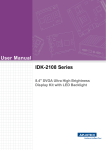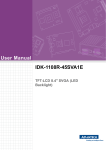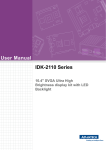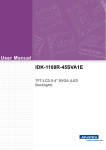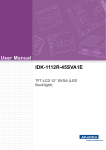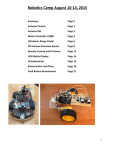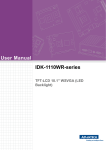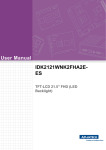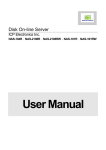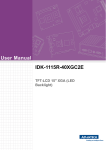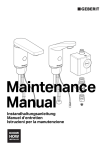Download User Manual IDK-2108 Series
Transcript
User Manual IDK-2108 Series 8.4" SVGA Ultra High Brightness Display Kit with LED Backlight Copyright The documentation and the software included with this product are copyrighted 2015 by Advantech Co., Ltd. All rights are reserved. Advantech Co., Ltd. reserves the right to make improvements in the products described in this manual at any time without notice. No part of this manual may be reproduced, copied, translated or transmitted in any form or by any means without the prior written permission of Advantech Co., Ltd. Information provided in this manual is intended to be accurate and reliable. However, Advantech Co., Ltd. assumes no responsibility for its use, nor for any infringements of the rights of third parties, which may result from its use. Acknowledgements AMI is a trademark of American Megatrends Inc. IBM and PC are trademarks of International Business Machines Corporation. Intel® Core 2 Quad, Pentium Dual Core and Celeron are trademarks of Intel Corporation. WinBond is a trademark of Winbond Corporation. All other product names or trademarks are properties of their respective owners. IDK-2108 User Manual Part No. 2006210803 Edition 5 Printed in Taiwan Aug. 2015 ii A Message to the Customer Advantech Customer Services Each and every Advantech product is built to the most exacting specifications to ensure reliable performance in the harsh and demanding conditions typical of industrial environments. Whether your new Advantech equipment is destined for the laboratory or the factory floor, you can be assured that your product will provide the reliability and ease of operation for which the name Advantech has come to be known. Your satisfaction is our primary concern. Here is a guide to Advantech’s customer services. To ensure you get the full benefit of our services, please follow the instructions below carefully. Technical Support We want you to get the maximum performance from your products. So if you run into technical difficulties, we are here to help. For the most frequently asked questions, you can easily find answers in your product documentation. These answers are normally a lot more detailed than the ones we can give over the phone. So please consult this manual first. If you still cannot find the answer, gather all the information or questions that apply to your problem, and with the product close at hand, call your dealer. Our dealers are well trained and ready to give you the support you need to get the most from your Advantech products. In fact, most problems reported are minor and are able to be easily solved over the phone. In addition, free technical support is available from Advantech engineers every business day. We are always ready to give advice on application requirements or specific information on the installation and operation of any of our products. iii IDK-2108 User Manual Declaration of Conformity FCC This device complies with the requirements in part 15 of the FCC rules: Operation is subject to the following two conditions: This device may not cause harmful interference This device must accept any interference received, including interference that may cause undesired operation. This equipment has been tested and found to comply with the limits for a Class B digital device, pursuant to Part 15 of the FCC Rules. These limits are designed to provide reasonable protection against harmful interference when the equipment is operated in a commercial environment. This equipment generates, uses, and can radiate radio frequency energy and, if not installed and used in accordance with the instruction manual, may cause harmful interference to radio communications. Operation of this device in a residential area is likely to cause harmful interference in which case the user will be required to correct the interference at his/her own expense. The user is advised that any equipment changes or modifications not expressly approved by the party responsible for compliance would void the compliance to FCC regulations and therefore, the user's authority to operate the equipment. Caution! There is a danger of a new battery exploding if it is incorrectly installed. Do not attempt to recharge, force open, or heat the battery. Replace the battery only with the same or equivalent type recommended by the manufacturer. Discard used batteries according to the manufacturer's instructions. IDK-2108 User Manual iv Product Warranty (2 years) Advantech warrants to you, the original purchaser, that each of its products will be free from defects in materials and workmanship for two years from the date of purchase. This warranty does not apply to any products which have been repaired or altered by persons other than repair personnel authorized by Advantech, or which have been subject to misuse, abuse, accident or improper installation. Advantech assumes no liability under the terms of this warranty as a consequence of such events. Because of Advantech’s high quality-control standards and rigorous testing, most of our customers never need to use our repair service. If an Advantech product is defective, it will be repaired or replaced at no charge during the warranty period. For outof-warranty repairs, you will be billed according to the cost of replacement materials, service time and freight. Please consult your dealer for more details. If you think you have a defective product, follow these steps: 1. Collect all the information about the problem encountered. (For example, CPU speed, Advantech products used, other hardware and software used, etc.) Note anything abnormal and list any onscreen messages you get when the problem occurs. 2. Call your dealer and describe the problem. Please have your manual, product, and any helpful information readily available. 3. If your product is diagnosed as defective, obtain an RMA (return merchandise authorization) number from your dealer. This allows us to process your return more quickly. 4. Carefully pack the defective product, a fully-completed Repair and Replacement Order Card and a photocopy proof of purchase date (such as your sales receipt) in a shippable container. A product returned without proof of the purchase date is not eligible for warranty service. 5. Write the RMA number visibly on the outside of the package and ship it prepaid to your dealer. v IDK-2108 User Manual IDK-2108 User Manual vi Contents Chapter 1 Overview...............................................1 1.1 1.2 General Description .................................................................................. 2 Specifications ............................................................................................ 2 1.2.1 LCD Panel..................................................................................... 2 1.2.2 LED Driver Board.......................................................................... 2 1.2.3 Touchscreen (R series)................................................................. 2 1.2.4 Environment.................................................................................. 2 Mechanical Characteristics ....................................................................... 3 Functional Block Diagram ......................................................................... 3 Figure 1.1 Function Block Diagram ............................................. 3 Touchscreen Driver................................................................................... 4 Absolute Maximum Ratings ...................................................................... 4 1.6.1 Absolute Ratings of TFT LCD Module .......................................... 4 1.6.2 Absolute Ratings of Backlight Unit................................................ 4 1.6.3 Absolute Ratings for Environment ................................................ 4 1.3 1.4 1.5 1.6 Chapter 2 Electrical Characteristics....................5 2.1 TFT LCD Power Specifications ................................................................. 6 Table 2.1: Power Specifications .................................................. 6 2.1.1 Signal Electrical Characteristics.................................................... 6 Table 2.2: Signal Electrical Characteristics ................................. 6 Backlight Driving Conditions ..................................................................... 7 Table 2.3: Backlight Driving Conditions....................................... 7 2.2 Chapter 3 Signal Characteristics .........................9 3.1 3.2 3.5 Pixel Format Image ................................................................................. 10 Signal Description ................................................................................... 10 Table 3.1: Symbol Description................................................... 10 The Input Data Format ............................................................................ 11 3.3.1 SEL68 ......................................................................................... 11 Interface Timing ...................................................................................... 13 3.4.1 Timing Characteristics ................................................................ 13 Table 3.2: Timing Characteristics .............................................. 13 Table 3.3: .................................................................................. 13 3.4.2 Input Timing Diagram.................................................................. 13 Power ON/OFF Sequence ...................................................................... 13 4 Connector & Pin Assignment ...........15 4.1 TFT LCD Module..................................................................................... 16 4.1.1 Connector ................................................................................... 16 Table 4.1: LVDS Connector....................................................... 16 4.1.2 Pin Assignment ........................................................................... 16 Table 4.2: Pin Assignment......................................................... 16 Backlight Unit .......................................................................................... 16 4.2.1 Signal for LED light bar connector .............................................. 16 4.2.2 LED Driver Board........................................................................ 17 Table 4.3: Specifications ........................................................... 17 Table 4.4: CN1 Input Connector Pin Definition.......................... 18 Table 4.5: CN4 Output Connector Pin Definition....................... 18 3.3 3.4 Chapter 4.2 vii IDK-2108 User Manual Table 4.6: CN2 Light Sensor Connector Pin Definition ............. 19 Table 4.7: CN3 Variable Resistor Connector Pin Definition ...... 19 Figure 4.1 Dimensions............................................................... 20 Chapter 5 Touchscreen & Touch Controller .... 21 5.1 Touchscreen (Optional: for IDK-2108R Only) ......................................... 22 5.1.1 Touch Characteristics ................................................................. 22 5.1.2 Optical Characteristics................................................................ 22 5.1.3 Environmental Characteristics .................................................... 22 5.1.4 Mechanical Characteristics......................................................... 22 5.1.5 Electronic Characteristics ........................................................... 22 Touch Controller (Optional: for IDK-2108R Only) ................................... 23 5.2.1 Touch Controller Characteristics ................................................ 23 5.2.2 Specifications.............................................................................. 23 5.2.3 Environmental Features.............................................................. 23 5.2.4 Pin Assignment and Description................................................. 24 Figure 5.1 Board mounted header............................................. 24 5.2 Appendix A Optical Characteristics..................... 27 A.1 Optical Characteristics ............................................................................ 28 Table A.1: Optical Characteristics ............................................. 28 Appendix B Handling Precautions ....................... 31 B.1 Optical Characteristics ............................................................................ 32 IDK-2108 User Manual viii Chapter 1 Overview 1 1.1 General Description IDK-2108 series is a Color Active Matrix Liquid Crystal Display composed of a TFTLCD panel, a driver circuit, and backlight system. The screen format supports an SVGA screen of 800 x 600 pixels (H x V) at 16.2M colors (RGB 8-bit) or 262k colors (RGB 6-bit). All input signals are LVDS interface compatible. Driver board backlight is included. 1.2 Specifications 1.2.1 LCD Panel Display Size: 8.4" LED backlight panel Resolution: 800 x 600 Viewing Angle (U/D/L/R): 80°/60°/80°/80° Brightness: 1200 cd/m2 Contrast Ratio: 600:1 Response Time (ms): 30 ms Colors: 6-bit (262K)/8-bit (16.2M) Voltage: 3.3V Power Consumption: 5.85 W Signal Interface: 1 channel LVDS Weight: R series: 338.5 g N series: 260 g Dimensions (W x H x D): R series: 203 x 142.6 x 10.3 mm N series: 203 x 142.5 x 8.0 mm 1.2.2 LED Driver Board Efficiency: 90% Output Current & Voltage: 500 mA/8.9 V Dimensions (W x H x D): 60x16x5 mm 1.2.3 Touchscreen (R series) Touchscreen: 4-Wire Resistive Transparency: 82.5% (Typ.) Durability: 1 million times 1.2.4 Environment Operating Temperature: -10 ~ + 60 °C (R- series) -20 ~ 70 °C (N- series) Storage Temperature: -30 ~ +70 °C (R- series) -30 ~ +85 °C (N- series) Humidity: 90% @ 39°C, non-condensing IDK-2108 User Manual 2 Chapter 1 1.3 Mechanical Characteristics IDK-2108N Series Overview IDK-2108R Series 1.4 Functional Block Diagram The following diagram shows the functional block of the 8.4 inch color TFT-LCD module: Figure 1.1 Function Block Diagram 3 IDK-2108 User Manual 1.5 Touchscreen Driver The touchscreen driver is available on Advantech's website. 1.6 Absolute Maximum Ratings Absolute maximum ratings of the module is as follows: 1.6.1 Absolute Ratings of TFT LCD Module Item Symbol Min. Max. Unit Conditions Logic/LCD Drive Voltage Vin 3 +3.6 [Volt] Note 1, 2 1.6.2 Absolute Ratings of Backlight Unit Item Symbol Min. Max. Unit Conditions LED Light Bar Current Led 490 500 [mA] Note 1, 2 1.6.3 Absolute Ratings for Environment Item Symbol Min. Max. Unit Conditions Operating Temperature TOP 10 +60 [oC] Operating Humidity HOP 90 [%RH] +70 [oC] 90 [%RH] For IDK2108RK2SVA2E only Storage Temperature TST Storage Humidity HST -30 Note 1: Maximum Wet-Bulb should be 39°C and no condensation. Note 2: Permanent damage to the device may occur if maximum values are exceeded. Note 3: For quality performance, please refer to AUO IIS (Incoming Inspection Standard). IDK-2108 User Manual 4 Chapter 2 Electrical Characteristics 2 2.1 TFT LCD Power Specifications Input power specifications are as follows: Table 2.1: Power Specifications Symbol Parameter Typ. Max. Unit Condition VDD Logic/LCD 3.0 Drive Voltage Min. 3.3 3.6 [Volt] 10% IDD Input Current - 270 330 [mA] 64 Gray Bar Pattern (VDD=3.3V, at 60Hz) PDD VDD Power 0.9 1.2 [Watt] 64 Gray Bar Pattern (VDD=3.3V, at 60Hz) Rush Inrush Current - - 3 [A] Note 1 - Note 1: Measurement condition: +3.3V Q3 AO6402 D6 D5 D2 D1 F1 S VDD VCC (LCD Module Input) G R1 47K (High to Low) Control Signal D1 D2 D5 D6 C1 1uF/16V Q3 AO6402 R2 S G 1K 2 C3 +12.0V SW1 1 SW MAG-SPST VR1 R2 0.01uF/25V 47K 1K C2 1uF/25V 3.3V 90% 10% 0V 470 us VDD rising time 64 Gray pattern 2.1.1 Signal Electrical Characteristics Input signals shall be low or Hi-Z state when VDD is off. Table 2.2: Signal Electrical Characteristics Symbol Parameter Min. VTH Differential Input High Threshold - - 100 [mV] VCM=1.2V VTL Differential Input Low Threshold -100 - - [mV] VCM=1.2V | VID | Input Differential Voltage 100 400 600 [mV] VICM Differential Input Common Mode Voltage 1.1 - 1.6 [V] Note: LVDS Signal Waveform. IDK-2108 User Manual 6 Typ. Max. Unit Condition VTH / VTL = 100mV Chapter 2 Parameter guidelines for LED light bar driver are under stable conditions at 25°C (Room Temperature): Table 2.3: Backlight Driving Conditions Item Symbol Values Min. Typ. Unit Condition Max. LED Voltage VL 8.7 8.9 V Note 2 LED Current IL 490 500 mA Note 2 LED Life Time - 50,000 - Hr Note 1 - Note 1: "LED life Time" is defined as a module brightness decrease of 50% original brightness, and an ambient temperature of 25°C with typical LED current at 500mA. Note 2: “LED Driving Condition” is defined for each LED module. (3 Serial LEDs, an LED includes 1 chip). Note 3: The LED Light Bar power consumption variance is 10%. Calculator value for reference (IL x VL = PLED) 7 IDK-2108 User Manual Electrical Characteristics 2.2 Backlight Driving Conditions IDK-2108 User Manual 8 Chapter 3 3 Signal Characteristics 3.1 Pixel Format Image The following figure shows the relationship between the input signal and LCD pixel format. 3.2 Signal Description Table 3.1: Symbol Description Pin No. Symbol Description 1 VDD Power Supply, 3.3V (typical) 2 VDD Power Supply, 3.3V (typical) 3 UD Vertical Reverse Scan Control. Low or NC -> Normal mode, Height -> Vertical Reverse Scan (Note) 4 LR Horizontal Reverse Scan Control. Low or NC -> Normal mode, Height -> Vertical Reverse Scan (Note) 5 RxIN1- 6 RxIN1+ 7 GND 8 RxIN2- 9 RxIN2+ 10 GND LVDS differential data input Pair 0 Ground LVDS differential data input Pair 1 Ground 11 RxIN3- 12 RxIN3+ 13 GND 14 RxCLKIN- 15 RxCLKIN+ 16 GND Ground 17 SEL68 LVDS 6/8 bit select function control, Low or NC 6 Bit Input Mode. High 8-bit Input Mode (Node) 18 NC NC 19 RxIN4- 20 RxIN4+ LVDS differential data input Pair 3. Must be connected to Ground in 6-bit input mode. IDK-2108 User Manual LVDS differential data input Pair 2 Ground LVDS differential Co-lock input Pair 10 Chapter 3 Note 1: "Low" stands for 0V. "High" stands for 3.3V. "NC" stands for "No Connected." Note 2: For reverse scan mode, please connect to 3.3V directly. A pull-up resistor on the input side will cause abnormal reverse scan. Signal Characteristics 3.3 The Input Data Format 3.3.1 SEL68 SEL68 = ”Low” or “NC” for 6-bit LVDS Input RxCLKIN RxIN1 G0 R5 R4 R3 R2 R1 R0 RxIN2 B1 B0 G5 G4 G3 G2 G1 RxIN3 DE VS HS B5 B4 B3 B2 SEL68 = “High” for 8-bit LVDS Input RxCLKIN RxIN1 G0 R5 R4 R3 R2 R1 R0 RxIN2 B1 B0 G5 G4 G3 G2 G1 RxIN3 DE VS HS B5 B4 B3 B2 RxIN4 RSV B7 B6 G7 G6 R7 R6 Note 1: Please follow PSWG. Note 2: R/G/B data 7:MSB, R/G/B data 0:LSB 11 IDK-2108 User Manual Signal Name Description R7 Red Data 7 R6 Red Data 6 R5 Red Data 5 R4 Red Data 4 R3 Red Data 3 R2 Red Data 2 R1 Red Data 1 R0 Red Data 0 G7 Green Data 7 G6 Green Data 6 G5 Green Data 5 G4 Green Data 4 G3 Green Data 3 G2 Green Data 2 G1 Green Data 1 G0 Green Data 0 B7 Blue Data 7 B6 Blue Data 6 B5 Blue Data 5 B4 Blue Data 4 B3 Blue Data 3 B2 Blue Data 2 B1 Blue Data 1 B0 Blue Data 0 RxCLKIN LVDS Data Clock DE Data Enable Signal VS Vertical Synchronous Signal HS Horizontal Synchronous Signal Remarks Red-pixel Data, For 8-bit LVDS input, MSB: R5; LSB:R0 Green-pixel Data, For 8-bit LVDS input, MSB: G7; LSB:G0 Blue-pixel Data, For 8-bit LVDS input, MSB: B7; LSB:B0 When the signal is high, the pixel data is valid to be displayed. Note: Output signals from any system shall be Low or Hi-Z state when VDD is off. IDK-2108 User Manual 12 3.4.1 Timing Characteristics Table 3.2: Timing Characteristics Table 3.3: Parameter Symbol Min. Typ. Max. Unit Clock Timing Clock frequency 1/ TClock 33.6 39.8 48.3 MHz Period TV 608 628 650 TH Vsync Timing Vertical Section Active TVD 600 600 600 TH Blanking TVB 8 28 50 TH Period TH 920 1056 1024 TClock Active THD 800 800 800 TClock Blanking THB 120 256 440 TClock Hsync Timing Horizontal Section Note: Frame rate is 60 Hz. Note: DE mode. 3.4.2 Input Timing Diagram 3.5 Power ON/OFF Sequence VDD power and Backlight on/off sequence is as follows. Interface signals are also shown in the chart. Signals from any system shall be Hi-Z state or low level when VDD is off. 13 IDK-2108 User Manual Signal Characteristics Signal Chapter 3 3.4 Interface Timing Power Sequence Timing Parameter T1 Value Unit Min. Typ. Max. 0.5 - 10 [ms] T2 30 40 50 [ms] T3 200 - - [ms] T4 0.5 - 10 [ms] T5 10 - - [ms] T6 10 - - [ms] T7 0 - - [ms] T8 10 - - [ms] T9 - - 10 [ms] T10 110 - - [ms] T11 0 16 50 [ms] T12 - - 10 [ms] T13 1000 - [ms] The above on/off sequence should be applied to avoid abnormal function in the display. Please make sure to turn off the power when you plug the cable into the input connector or pull the cable out of the connector. IDK-2108 User Manual 14 Chapter 4 Connector & Pin Assignment 4 4.1 TFT LCD Module The physical interface described is for the connector on module. These connectors are capable of accommodating the following signals and components listed. 4.1.1 Connector Table 4.1: LVDS Connector Connector Name / Description Signal Connector Manufacturer STM or Compatible Connector Model Number STM-MSB24013P20HA or Compatible Adaptable Plug STM-P24013P20 4.1.2 Pin Assignment Table 4.2: Pin Assignment Pin No. Signal Name Pin No. Signal Name 1 VDD 2 VDD 3 UD 4 LR 5 RxIN1- 6 RxIN1+ 7 GND 8 RxIN2- 9 RxIN2+ 10 GND 11 RxIN3- 12 RxIN3+ 13 GND 14 RxCLKIN- 15 RxCLKIN+ 16 GND 17 SEL68 18 NC 19 RxIN4- 20 RxIN4+ 4.2 Backlight Unit The physical interface described is for the connector on module. These connectors are capable of accommodating the following signals and components listed. Connector Name / Designation LED Light Bar Connector / Backlight Lamp Manufacturer JST or compatible Type Part Number WF-SMT90 1.5mm Wire to board Heater Mating Type Part Number NA 4.2.1 Signal for LED light bar connector Connector No. Pin No. Lower CN2 Input Color Function 1 HI 2 Red Power supply for backlight unit 2 GND 2 Black Ground for backlight unit Cable Length : 250mm+/-10mm IDK-2108 User Manual 16 4.2.2.1 Specifications: Table 4.3: Specifications Symbol Input Condition Voltage Min. Typ. Max. Unit 11.2 12 13.2 V Efficiency 90 Voltage 8.7 9 10.5 V Current 475 500 550 mA 5 Current Accuracy Protection ON/OFF % OVP, UVLO Environment Operating Temperature PWM Dimmer % -30 +85 °C Storage Temperature -40 +105 °C Dimmer range (Note. 1) 5 100 % Dimmer VH 5 V Dimmer VL 0 V Dimmer Frequency 0.5 40 KHz Von 3 5 V Voff 0 0.8 V Note 1: When the input PWM signals, the high-level digital output must be greater than the total output level at 5% output. 4.2.2.2 Connector Model No & Brand Connector No. Connector Parts No Brand CN1 S6B-ZR-SM4 JST or compatible CN2 S2B-ZR-SM4 JST or compatible CN3 S3B-ZR-SM4 JST or compatible CN4 S2B-ZR-SM4 JST or compatible 17 Remark IDK-2108 User Manual Connector & Pin Assignment Output Characteristics Chapter 4 4.2.2 LED Driver Board 4.2.2.3 Input Connector Pin Definitions Table 4.4: CN1 Input Connector Pin Definition Pin No. Pin Definition 1 Vin (+12V) 2 Vin (+12V) 3 GND 4 GND 5 ON/OFF (ON:+3~5V, OFF=0~0.8V) 6 Dimming (PWM) 4.2.2.4 Output Connector Pin Definition Table 4.5: CN4 Output Connector Pin Definition Pin No. Pin Definition 1 VLED+ 2 VLED- IDK-2108 User Manual 18 Chapter 4 4.2.2.5 Light Sensor Connector Pin Definition Table 4.6: CN2 Light Sensor Connector Pin Definition Pin No. Pin Definition 1 Sensor High Voltage 2 SensorLow Voltage Table 4.7: CN3 Variable Resistor Connector Pin Definition Pin No. Pin Definition 1 VR High Voltage 2 VR 3 VR Low Voltage 4.2.2.7 Brightness Control Signal Flow Chart 19 IDK-2108 User Manual Connector & Pin Assignment 4.2.2.6 Variable Resistor Connector Pin Definition 4.2.2.8 Dimensions Figure 4.1 Dimensions IDK-2108 User Manual 20 Chapter 5 5 Touchscreen & Touch Controller 5.1 Touchscreen (Optional: for IDK-2108R Only) 5.1.1 Touch Characteristics The touch panel is a resistance type that customers use with flat displays like LCDs. Once an operator touches it, the circuit will send coordinate points to the PC from the voltage changes at the contact points. 5.1.2 Optical Characteristics Item Specifications Remarks 1 TRANSPARENCY 82.5% Typ. 80% Min. (Active area) (Inside of guaranteed active area) JIS K-7105 2 HAZE 8.0% Typ. (Anti-glare) JIS K-7105 5.1.3 Environmental Characteristics Item Specifications Remarks 1 Operational temperature -10°C ~ 60°C 2 Storage temperature -30°C ~ 70°C Max. wet temp is 38°C (No dew) 3 Operational Humidity 20% ~ 90%RH 4 Storage temperature 10% ~ 90%RH 5.1.4 Mechanical Characteristics Item Specifications Remarks 1 Hardness of surface Pencil hardness 3H. JIS K-5600-5-4 150gf, 45 degree 2 FPC peeling strength 1) 5N (5N Min.) 2) 19.6N (19.6N Min.) 1) Peeling upward by 90° 2) Peeling downward by 90° 3 Operational force Pen Dot-Spacer Within “guaranteed active area”, but not on the age and Dot-Spacer. Finger 0.05N~1.96N (5~200gf) 5.1.5 Electronic Characteristics Item Specification Remarks 1 Rated Voltage DC 7V max. 2 Resistance X axis: 200 ~ 1000(Glass side) FPC connector Y axis: 100 ~ 800(Film side) 3 Linearity ±1.5%max initial value ±2.0%max (after environmental & life test) 4 Chattering 20ms Max At connector pin 5 Insulation Resistance 10M @ (DC 25V) 10M min (DC 25V) IDK-2108 User Manual 22 Reference: 250gf 5.2.1 Touch Controller Characteristics Advantech ETM-RES05C Touch Control Board is the ultimate combo board. This touch panel controller provides optimized performance for your analog resistive touch panel 4-wire model. It communicates with the PC system directly through USB and RS-232 connector. The touch panel driver emulates mouse left and right button functions. Electrical Features +5 Vdc/ 100 mA typical, 50mV peak to peak maximum ripple and noise. Bi-directional RS-232 serial communication and USB 1.1 full speed Report rate of RS-232 is 180 points/sec (max.). And, USB is 200 points/sec (max.) Unaffected by environmental EMI Panel resistance of 4-wire resistive model is from 50 to 200 ohm (Pin to pin on same layer) Touch resistance under 3K ohm Serial Interface EIA 232E (Serial RS-232) No parity, 8 data bits, 1 stop bit, 9600 baud (N, 8, 1, 9600) Support Windows 2000/ Vista/ XP/ 7, Windows CE 5.0/ 6.0/ 7.0, Windows NT4, Linux, DOS, QNX USB Interface Conforms to USB Revision 1.1 full speed. If the USB is connected to the controller, the controller will communicate over the USB, and will not communicate over the serial port. Support Windows 2000/ Vista/ XP/ 7, Windows CE 5.0/ 6.0/ 7.0, Linux, QNX Touch Resolution 2,048 x 2,048 resolution Response Time Max. 20 ms 5.2.3 Environmental Features Reliability MTBF is 200,000 hours Temperature Ranges Operating : -25°C ~ 85°C Storage: -25°C ~ 85°C Relative Humidity 23 IDK-2108 User Manual Touchscreen & Touch Controller 5.2.2 Specifications Chapter 5 5.2 Touch Controller (Optional: for IDK-2108R Only) 95% at 60°C, RH Non-condensing Acquired RoHS certificate Regulatory FCC-B, CE approvals Dimension: 75 mm x 20 mm x 10 mm 5.2.4 Pin Assignment and Description 5.2.4.1 Connector and LED Location JP1 Connector (USB&RS-232 Combo Interface) JP2 Connector (4-wire Touch screen interface) LED 5.2.4.2 Combo Interface Connector, JP1, Pins and Signal Descriptions The combo interface connector, USB and RS-232, is a box 2.0mm 10-pins 90 degree, Male type with lock connector, intended to be used with single wired pins in 5+5 pins header. The pins are numbered as shown in the table below. USB Pin# Signal Name Signal Function RS-232 Pin# Signal Name Signal Function 1 G Ground 1 G Ground 2 V USB Power 2 V Power 3 G Ground 3 G Ground 4 D+ USB D+ 4 TxD Serial Port 5 D- USB D- 5 RxD Serial Port Signal Name DB-9 pin # RS-232 pin # Sourced by Signal Description RxD 2 5 ctlr serial data from controller to host TxD 3 4 host serial data from host to controller Figure 5.1 Board mounted header IDK-2108 User Manual 24 Signal Name Signal Description 1 YB Bottom 2 XL Left 3 YT Top 4 XR Right 4-Wire Touch Screen ZIF connector 4-Wire Screen viewed from coversheet side 25 IDK-2108 User Manual Touchscreen & Touch Controller TS4 Pin # Chapter 5 5.2.4.3 Touch Screen Connector, JP2, Pins and Signal Descriptions The Touch Screen connector, JP2, is a FFC/FPC SMD 1.0mm 4-pins 90 degree, Female type connector. The pins are numbered as shown in the table below. IDK-2108 User Manual 26 Appendix A A Optical Characteristics A.1 Optical Characteristics The optical characteristics are measured under stable conditions at 25°C (Room Temperature): Table A.1: Optical Characteristics Item Unit Conditions [degree] Horizontal (Right) 80 CR = 10 (Left) 80 Vertical (Upper) 80 Viewing Angle CR = 10 Luminance Uniformity Min. (Lower) Typ. 60 Max. Note - [%] 9 Points 80 85 - [msec] Rising - 20 30 Falling - 10 20 Rising + Falling - 30 50 White x - 0.313 - White y - 0.322 - Optical Response Time Color/Chromaticity Coordinates (CIE 1931) 1 2, 3 5 4 Color Temp. K - 6500 White Luminance [cd/m2] 1100 1200 - 4 - 600 - 4 Contrast Ratio Note: Optical Equipment: BM-7, DT-101, or equivalent Note 1: Definition of viewing angle Viewing angle is the measurement of contrast ratio, at the screen center, over a 180° horizontal and 180° vertical range (off-normal viewing angles). The 180° viewing angle range is broken down as below: 90° ) horizontal left and right, and 90° () vertical high (up) and low (down). The measurement direction is typically perpendicular to the display surface with the screen rotated to its center to develop the desired measurement viewing angle. IDK-2108 User Manual 28 90 % 50 % 10 % 10 % 50 % 90 % Note 3: The luminance uniformity of 9 points is defined by dividing the maximum luminance values by the minimum test point luminance Minimum Brightness of nine points W9 = Maximum Brightness of nine points Note 4: Measurement method The LCD module should be stabilized at a given temperature for 30 minutes to avoid abrupt temperature changes during measuring. In order to stabilize the luminance, the measurement should be executed after the backlight has been lit for 30 minutes in a stable, windless and dark room using optical equipment: DT-100 or equivalent. 29 IDK-2108 User Manual Appendix A Optical Characteristics Note 2: 9-point position Note 5: Definition of response time The output signals of the photo detector are measured when the input signals are changed from "Full Black" to "Full White" (rising time), and from "Full White" to "Full Black" (falling time), respectively. The response time is the interval between 10% and 90% of the amplitudes. Please refer to the figure below. % Tf Tr 100 90 Optical White Black response 10 0 IDK-2108 User Manual 30 White Appendix B B Handling Precautions B.1 Optical Characteristics The optical characteristics are measured under stable conditions at 25°C (Room Temperature) 1. Since the front polarizer is easily damaged, pay attention not to scratch it. 2. Be sure to turn off power supply when inserting or disconnecting from the input connector. 3. Wipe off water drops immediately. Long contact with water may cause discoloration or spots. 4. When the panel surface is soiled, wipe it with absorbent cotton or other soft cloth. 5. Since the panel is made of glass, it may break or crack if dropped or bumped on hard surface. 6. Since CMOS LSI is used in this module, take care of static electricity and insure human earth when handling. 7. Do not open or modify the module assembly. 8. Do not press the reflector sheet at the back of the module in any directions. 9. In case a module has to be put back into the packing container slot after it was taken out from the container, please press the far ends of the LED light bar reflector edge softly. Otherwise the TFT Module may be damaged. 10. At the insertion or removal of the Signal Interface Connector, be sure not to rotate nor tilt the Interface Connector of the TFT Module. 11. After installation of the TFT module into an enclosure, do not twist nor bend the TFT module even momentary. At designing the enclosure, it should be taken into consideration that no bending/twisting forces are applied to the TFT module from outside. Otherwise the TFT module may be damaged. 12. Small amount of materials having no flammability grades are used in the LCD module. The LCD module should be supplied with power complying with requirements of Limited Power Source (IEC60950 or UL1950), or have applied for exemption. IDK-2108 User Manual 32 Appendix B Handling Precautions IDK-2108 User Manual 33 www.advantech.com Please verify specifications before quoting. This guide is intended for reference purposes only. All product specifications are subject to change without notice. No part of this publication may be reproduced in any form or by any means, electronic, photocopying, recording or otherwise, without prior written permission of the publisher. All brand and product names are trademarks or registered trademarks of their respective companies. © Advantech Co., Ltd. 2015










































